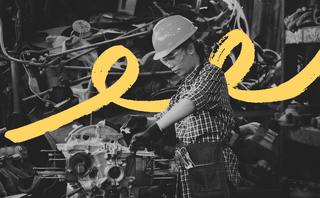In 2017, The New York Times ran an article titled “For Young Entrepreneurs, College Debts Can Snuff Out Start-Up Hopes.” The piece followed several late twentysomethings as they attempted to get their small businesses up and running while making student loan payments. Most struggled to juggle both, eventually shuttering their businesses to focus on paying back their loans.
There seem to exist fewer articles about what it means to be thirtysomething, or even fortysomething, entrepreneurs running a small business and still juggling student debt. The U.S. Census Bureau revealed in 2015 that 45 million Americans will be in their 30s within nine (now five) years’ time. Unlike previous generations, student debt will prevent them from reaching certain financial security milestones sooner.
The freedom to pursue entrepreneurship and to become your own boss is one such milestone. Thirty and fortysomething entrepreneurs may be faced with the choice to give up their startup — or find a balancing act to pursuing their dreams while paying off student loan debt.
Can entrepreneurs in their thirties and forties pay student loans while simultaneously running a small business? Absolutely. My own student debt is (fortunately) behind me, so I decided to ask a few thirtysomething small business owners the best approaches for juggling debt with a startup.
Apply For Income-Driven Repayment (IDR) Plans
Stanley Tate is a student loan lawyer at Tate Esq LLC. At 39-years-old, Tate runs his own law firm while making payments on his federal student loans. Since he only has federal student debt, Debt advises applying for an income-driven repayment (IDR) plan.
What are income-driven repayment plans? Income-driven repayment is designed to reduce the monthly payment amount of your federal student loan debt. They are available as four types of plans.
- Revised Pay As You Earn Repayment Plan (REPAYE)
- Pay As You Earn Repayment Plan (PAYE)
- Income-Based Repayment Plan (IBR)
- Income-Contingent Repayment Plan (ICR)
Tate applied for an income-driven repayment plan so he has a low base payment. A lower payment allows him to better juggle student debt with the expenses of his law firm. “My thinking is that with my business, I’m not always sure how much I’m going to bring in each month. I want to make sure I always have a payment I can afford.”
Pay More Than The Minimum Debt Owed
John Holloway is the 33-year-old co-founder of NoExam, a company that allows consumers to purchase life insurance online. Holloway was able to pay off his own student loans after starting a business in college. When he got married, his wife had a sizeable amount of student loan debt. Holloway had just started a new business and the pair had two children.
Holloway recalls that they struggled for about a year to make the minimum monthly payments. “While we were paying the minimums, the balances never seemed to go down, or at least not very fast. It felt like being on a treadmill.”
As things improved with the new business, they began paying more than the minimum amount owed each month. This made all the difference in helping get Holloway and his family out of student loan debt.
“Now that we pay more, the balance is going down much faster,” Holloway says, “Always pay more than the minimum, especially if the loan amount is high — over $15k. Do whatever it takes to get that balance down, like working around the clock on your business, to throw a few extra hundred dollars on the loans each month.”
Make a Major Lifestyle Adjustment
Some entrepreneurs may not be able to imagine sacrificing major assets like cars or homes, even temporarily, to get out of student debt and focus on their small businesses. However, that is exactly what 37-year-old Nicole Pereira did to live student debt-free.
Pereira, CEO of Chief Martech Officer and HubSpot expert, graduated from college in 2006 with $42k in federal student loans. Pereira spent a few years taking classes at a local community college to stave off student loan payments before landing her first corporate job in 2009. She had a son and daughter, two years apart, during this time and began making minimum payments on her student loan balance. Almost a decade after she started making the payments, Pereira owed $40k in student loans — whittling down a mere $2k of the principal balance.
Pereira decided to take matters into her own hands. She started a side hustle in 2010 that eventually grew to become a 20-person marketing agency while sticking to a strict financial budget. In 2017, a catastrophic business event caused Pereira to sell her home for a profit. This sale allowed Pereira to live off half the proceeds and save the company from ruin.
Business got back on track again by 2018, but by then Pereira and her family made the decision to go debt free. Because they had been living so frugally for so long, they found themselves with a large surplus of cash. That cash was used to pay off credit card debt, the remaining student loan balance, and buy a car within six months. Today, Pereira and her family are debt free—and also run a debt-free business with reserves.
“Having an asset worth something to sell in a pinch is super smart,” Pereira says. If entrepreneurs have the means — especially if they possess big ticket items — to make a lifestyle change to pursue a student debt-free life, they should do it now. “Not having debt allows you to better roll with life’s unexpected situations.”





